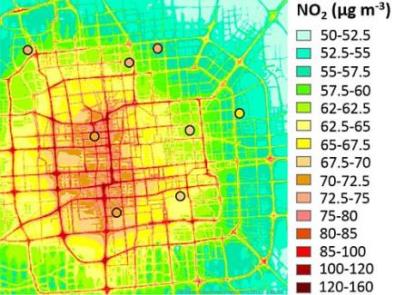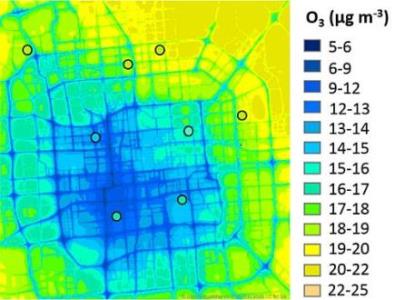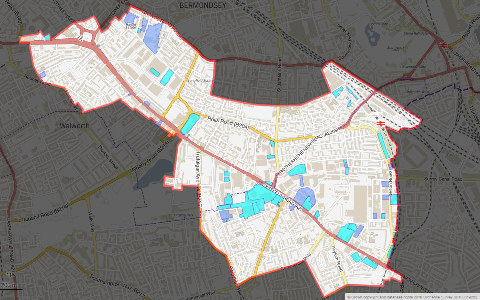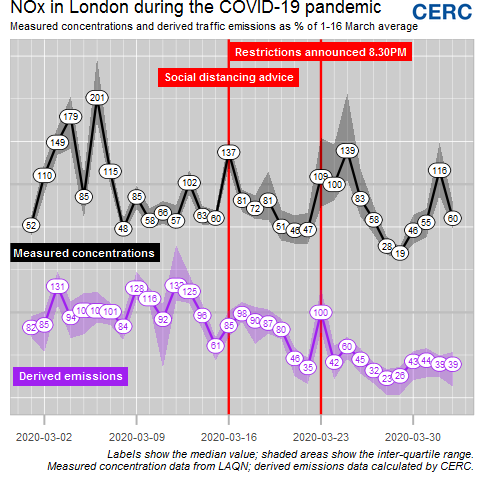CERC news
< Previous123456789101112131415161718192021Next >


4 Jun 2020Latest CERC research published
Apart from offering environmental consulting services and developing world-leading modelling software, CERC is actively supporting and engaged in research in a range of environmental modelling topics, with three papers being published in recent months.
Our high resolution air dispersion model, ADMS-Urban, has been used to model air quality in Beijing. Research undertaken by CERC's CASE student, Michael Biggart at the University of Edinburgh, has been published in the paper 'Street-scale air quality modelling for Beijing during a winter 2016 measurement campaign'. One challenge of this work was to develop an emissions inventory for this megacity; model predictions have been compared to air quality measurements recorded during the NERC-funded project: 'An Integrated Study of AIR Pollution PROcesses in Beijing (AIRPRO)'. The figures show period-average measurements overlaid on modelled pollutant contours (NO2, top and ozone, bottom) for the region within Beijing's fifth ring road.
Results from one of the first applications of CERC's emissions-optimisation scheme have been published (Carruthers et al., 2019). This method applies a Bayesian inversion technique to high resolution ADMS-Urban modelled concentrations in order to modify pollutant emission rates based on sensor data. The scheme was tested in Cambridge using monitored data from four Cambridge City Council air quality reference monitors and 20 AQMesh sensor pods provided by the University of Cambridge. The optimisation scheme improved model accuracy at the reference sites by reducing estimated road emissions by 6.5% on average and changed the diurnal profile of emissions. This same scheme has been used to estimate emissions reductions resulting from COVID-19 restrictions in London (see 9th April News item).
An article describing the 'Personalised Real-Time Air Quality Informatics System for Exposure – Hong Kong' (PRAISE-HK) system has been published (Che et al., 2020). CERC have been working closely with the Hong Kong University of Science and Technology on this smart city initiative since 2017. The project involves integration of a Linux version of ADMS-Urban in combination with the CMAQ regional model and WRF meteorological data using our Regional Model Link. A real-time personalised exposure app for mobile devices has been developed as part of this project.
For more information about our research, read more of our co-author publications, view our presentations, or contact us. You can also read how other groups are using our environmental software products for research.

29 May 2020Addressing air quality in London's Old Kent Road
The Old Kent Road (OKR) has been designated as an Opportunity Area in the London Plan and Southwark Council are preparing an Area Action Plan. Under the plan, the area will see the addition of 20,000 new homes, 10,000 new jobs and the extension of the Bakerloo Line. With this expected growth, Southwark Council has commissioned CERC to carry out an air quality study to provide a robust, holistic evidence base to support the OKR Area Action Plan air quality policy, which includes modelling wind flows and air quality.
CERC will use ADMS-Urban to assess air quality across the OKR area, accounting for the impact of multiple developments on traffic flows and emissions, and the effect of changes to the built form on the dispersion of pollutants. This requires the use of the urban canopy and advanced street canyon features of ADMS-Urban.
The study will also identify potential air pollution hotspots using highly spatially resolved 3D flow and turbulence fields generated by Wirth Research. This specialised Computational Fluid Dynamics (CFD) output will drive dispersion processes modelled in ADMS-Urban. The ability to import and use 3D CFD data is currently available in the industrial source model ADMS 5, and will be added to ADMS-Urban under this project.
CERC will analyse the differences and similarities between results generated using the two modelling approaches. We will identify toxic pollutant hotspots in the OKR area and make recommendations to mitigate the effects of poor air quality through design solutions, including orientation and layout of buildings and ventilation systems.

14 Apr 2020MAQS-Health: Multi Model Air Quality System for Health Research
CERC is leading a major new and ambitious project, MAQS-Health, which will provide a high resolution prediction capability for outdoor air quality, to support research on personal exposure and health impacts. The 2-year project is developing a coupled air quality modelling system spanning national to urban street scales and accounting for physical and chemical processes at all relevant temporal and spatial scales. The system will be flexible, linking established regional chemical transport models including CMAQ, CAMx, EMEP and WRF-Chem and a new street-scale model ADMS-Local derived from the widely used model ADMS-Urban. A verification module will enable validation of model predictions. The project is funded under the Clean Air Programme of the Strategic Priorities Fund (SPF). The coupled system and ADMS-Local will be available to the UK research community via the SPF Clean Air Framework platform and will have an open structure facilitating system development and modification. The project team brings together CERC's experts in software development and application of local dispersion models (ADMS), and regional model experts from the universities of Birmingham, Edinburgh, Hertfordshire and Lancaster. The team are working closely with the Met Office who led the call for this project, and will continue to liaise with stakeholders as the project progresses.

9 Apr 2020Assessing the drop in London road traffic emissions during COVID-19 restrictions
The restrictions imposed by the UK Government to limit the spread of COVID-19 have led to unprecedented reductions in the volume of road traffic; the latest Government figures suggest that vehicle use has dropped to 40% of normal levels. Discerning the impact of this on air quality in our towns and cities is difficult however, because air quality is heavily dependent on the weather. In typical windy UK conditions, poor air is rapidly mixed with cleaner air from above, so only those nearest to the busiest roads experience poor air quality. However, when the wind is light, as it was during the fine sunny weather that immediately followed the imposition of COVID-19 restrictions on 23rd March, traffic pollution emitted into stagnant air builds up, leading to more widespread poor air quality. So how can we tease out the impact of the known recent reduction in vehicle use from measured air quality data?
Scientists at CERC have analysed recent measured air quality data from across London using a mathematical technique (Carruthers et al., 2019) that combines measured air pollution concentration data with CERC's ADMS-Urban air quality model to derive an estimate of the underlying road traffic emissions that caused the measured concentrations. The figure shows how measured concentrations and derived emissions have changed since the 16th March, when the Government first issued social distancing advice (a high-resolution figure is here). The derived emissions first show a marked drop over the weekend of 21st/22nd March, which coincides with the announcement on the evening of Friday 20th March that bars and restaurants should close. Monday 23rd March saw a widely-reported rush hour in London; this can be seen in both the measured concentrations and the derived emissions. The impact of the restrictions announced in the evening of 23rd March can be seen in the derived emissions in the following days, even though measured concentrations continued to rise through Wednesday, due to the sunny and still weather conditions. The lowest derived emissions are seen on the weekend of 28th/29th March, averaging 24% of pre-restriction levels. Weekday derived emissions of consistently around 40% of pre-restriction levels contrasts with a second peak in measured concentrations on 1st April, again due to still weather conditions. From today, CERC's air quality forecasting services for London and the South-East have been adjusted to include this temporary reduction in road traffic.
By combining air quality monitoring with dispersion modelling, CERC scientists have been able to show that as well as limiting the spread of COVID-19, the Government restrictions are leading to a reduction in traffic emissions in London. In more normal times in future, this type of analysis can help uncover the true impact of emissions-reduction strategies on local air quality.
3 Apr 2020Major new release of ADMS-Urban, ADMS-Roads & ADMS-Airport
Version 5 is a major update of ADMS-Urban, ADMS-Roads and ADMS-Airport with many powerful new features to aid modelling, data processing and visualisation.
ADMS-Urban, ADMS-Roads and ADMS-Airport are comprehensive tools for investigating air pollution taking account of complex urban morphology including street canyons and road tunnels. ADMS-Roads is designed primarily for networks of roads that may be in combination with industrial sites, for instance small towns or rural road networks. ADMS-Urban can model large urban areas providing output from street-scale to urban-scale. ADMS-Airport has the features of ADMS-Urban, and can also incorporate all relevant emission sources at airports by using algorithms designed specifically to model dispersion from aircraft engines.
Some of the new features in version 5 include
- Run splitting: option to automatically break a large modelling region into smaller spatial regions, which can be distributed across your available processors to significantly reduce turnaround times. Ideal when using Run Manager
- Source exclusion: option to exclude low-emitting sources from the model run, which can help to reduce run times.
- Source apportionment: output the contribution of each source to each receptor, along with visualisation in the Mapper.
- EFT 9.0: includes the latest UK emission factors, which include the effects of road gradients on emissions from heavy goods vehicles.
- Time-varying emissions: Now allows for different factors for specific source-pollutant combinations.
- Plus many enhanced usability functions throughout the Mapper and interface.
All the new features are described in detail in the What's New? guides.
Users with support will get this version within the next few working days.
For further information on this release or any CERC products please email us.
You can also follow CERC news on Facebook, Twitter, LinkedIn and by RSS.
< Previous123456789101112131415161718192021Next >

